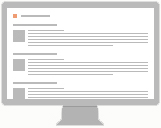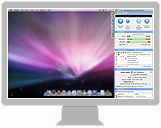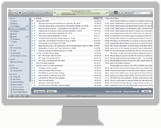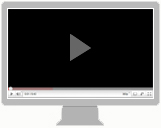I went to school with a lot of furniture designers. They made beautiful things. But they’d get pretty caught up in techniques—dovetail joints, lamination, etc.—and end up making pieces that simply afforded them the opportunity to use those techniques. You’d sometimes look at the results and wonder who would actually use them now that they were built. Furniture is meant to support and hold things; bookshelves for books, desks for paperwork and tools, tables for meals, beds, chairs and couches for people. A good piece of furniture is designed for its function, and as such may use some of those fancy techniques designers crave to try. Web design has the same relationship between technique and purpose, and like furniture, websites have one basic function: to support and hold content.
But content is still a pretty mysterious thing to many people. Everyone gets that it’s important; talking about content in terms of how important it is tends to elicit all kinds of specific questions, like, “What kinds of content?” “How much content?” “Can I use content from other websites?” and many more. And frankly, we have tons of content about content on our website that, in the aggregate, will answer all these questions. But in this article, I want to go back to the basics and look at the various kinds of content you might create for your website and examine best practices for each…
6 Types of Content in Under a Minute
Below is a list of six of the most common forms of web content, ordered from easiest to most difficult to implement. For each type, I’ve tried to concisely summarize each one so that you can get the most essential information you need to get started in under a minute.
(Emphasis on concise—this is by no means exhaustive! For more information on some of the topics, I’ve included links to additional articles.)


Blogs
You may have heard that blogging is dead. Don’t believe it. Blogging is alive and well, and likely one of your best bets for a lasting and consistently effective content strategy. A couple of years ago, I wrote all kinds of provisos for why not to start a blog in order to affirm some of the non-negotiables of blogging, and they’re all still true today.
First and foremost, make sure your expectations are in order. Blogging is a long-term strategy, and takes a cumulative approach to tell an ongoing story with many short posts. That means you want to consistently publish original 500-800 word posts on your website, ideally several on a weekly basis. If you started a blog two years ago and your “Hello World” post is still on the first page, please take down your blog until you’re certain you can commit to it. It’s going to take a lot of time and perseverance to gain traction; don’t expect instant engagement. Oh, and it’s not a blog if it doesn’t have commenting and an RSS feed.
Further reading on blogging:
Is it Time to Start a Blog?
Guiding Your Blog Out of the Wilderness
Writing a Blog Mission Statement
Short or Long Format Writing
How to Blog (webinar)


Newsletters
Like blogs, newsletters are a great format for your written content strategy. Unlike blogs, newsletters are long-format content—1000-2000 words is ideal—that develop a single idea in a more in-depth manner contained in one article. That doesn’t mean they take any less work to do well. What your newsletters may lack in terms of brevity and frequency, they certainly make up in the research required and the slightly higher level of formality expected.
Because you’re publishing less frequently (we recommend monthly at most, quarterly at least), you want to think of your newsletters as “going on the record” on behalf of your firm. So make sure the ideas they contain are as tested as possible—at the rate of 12 per year, it will take far longer to bury an ill-conceived idea in this format than in your blog.
Further reading on newsletters:
How to Write a Newsletter
Managing a Newsletter Campaign
4 Ways to Improve Your Email Newsletters
Better Newsletter CTA’s


Whitepapers
These are much the same as newsletters, but the issues of formality and conceptual indispensability are even more relevant. Whitepapers are more along the line of position-papers representing how your firm thinks about or does things. While that isn’t a major distinction from how you might consider your newsletter, it will have some particular effects upon how you go about creating and delivering whitepapers.
Whitepaper content is likely to have much deeper and more direct ties to your positioning, so it’s not likely to change that frequently—meaning you may write a handful of these a year at most. And because of the value of some whitepapers, particularly those with proprietary information in them, often the delivery of this material comes at a price—either actual dollars or information. So before you adopt this format, be sure there’s a market for it.


Webinars
Webinars are informational sessions that you conduct using software (we recommend GoToWebinar) that enables an audience to register in advance for attendance, see your screen and hear your voice as you present, and engage with you either audibly or via instant messaging during a Q&A period. Conceptually, they are kind of like live versions of newsletters, in that they ideally exist in a place somewhere between casual and formal. Because webinars are done live, think of them as somewhere in between a public speaking engagement and a conversation with a prospect. The sweet spot in the midst is actually more akin to a classroom experience. You are the teacher, your attendees your students.
As far as the presentation of your webinars is concerned, some basic teaching principles actually apply quite well. First, structure and review are essential. Clearly lay out your objectives and stop often to recap on what you’ve covered. Then review again. Also, all students have lower threshholds than most new teachers anticipate. Keep your presentation to 30-45 minutes and leave about 15 minutes for questions. This kind of content takes a lot of work and energy to sustain, so don’t be too ambitious with the schedule. Quarterly is plenty.


Audiocasts
The production value of some of the better audiocasts out there sets a very high bar. If you can’t come close to the craft of existing programs dealing with similar content to what you’d create, think twice about starting your own. I can’t count how many audiocasts I’ve subscribed to and then immediately unsubscribed from after hearing just a portion of one episode. If it doesn’t sound good, listeners won’t stick around.
The level of quality should also have direct correspondence to the length of the program. The shorter your audiocast, the more leeway you might have with not-so-professional quality. The longer it is, the more professional it will need to be. Also consider your ability to maintain production. A successful audiocast is one that sticks to a regular schedule and persists. Having three mp3’s available on iTunes doesn’t exactly count as a regular schedule. By the way, audiocasts are ideally subscribable using an audio-file-friendly RSS feed and listed in the iTunes directory.


Videocasts
The quality considerations I mentioned about audiocasts are just as relevant, if not more, to video. However, there is probably much more room for quickly produced video pieces than audio, because users actually get to see something in addition to hearing it. This is why quick webcam-recorded videos uploaded to tools like YouTube, Vimeo or Viddler and embedded on your page could be just fine. If you’re hoping to create videos with higher production quality, perhaps even scripted, you’re going to need to do a lot of planning and allocate a real budget. But keep in mind that the higher the quality, the more difficult the production of your videos will be to sustain (unless you’re already equipped and do regular video production)
One final consideration: Embeddable Flash-based video players are great for offloading bandwidth and other technical considerations and simplifying the process for you. But, they will not be visible on your page for Mac-based mobile device users, the only exception being YouTube—in that case, Apple’s YouTube application will play the video.
Further reading on video:
Creating Videos for Use on the Web
A Simple (but good) Example of Video Made for the Web
How Video is Changing Advertising and Marketing

Additional Content Strategy Resources
Developing an Effective Content Strategy
Content Strategy for Agencies (webinar)
Who Are You Speaking To?
A Value-Based Content Strategy
Professional Writing for the Unprofessional Writer


